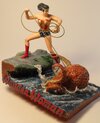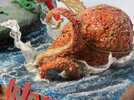Solo4114
Master Member
So, I'm coming to this angle of the hobby from a sort of roundabout approach.
Among other things, I'm a GM and planning to run some West End Games d6 Star Wars. I know it can all be run "theater of the mind," but I think it's also fun to have miniatures. Towards this end, I've been scooping up X-wing miniatures auctions on ebay, buying lots, parting out the stuff I don't want, and hanging on to the rest. (I may keep the rules, too, in case I ever wanna play, but that's a separate discussion.)
ANYWAY, I'm planning on running an adventure set around destroying an asteroid base with some huge guns on it that is locking down all approach to a planet the Rebels want to free from Imperial control. The base is located in an asteroid field, and is set on an especially large asteroid. I plan to open the game in media res with the players attacking the base in a hopeless attack using X-wing and Y-wing miniatures. So, off the bat, we're talking ~1:270 scale here. (I know the X-wing models aren't 100% accurate to that, but it's...eh...close enough.)
So I'm trying to figure out how to build an Imperial base set into an asteroid that will feature a bunch of anti-starfighter and ship defenses. Facilities, turbolaser turrets, the works, plus two huge guns capable of destroying pretty much any larger ship that might approach the planet.
For the guns, I'm debating using two HobbyBoss 1:72 2S19-M2 self-propelled artillery guns where I'm basically just using the turret/cannon assembly. Alternatively, I'd use a single 1:35 Takom 2155 VT 1-2 tank. I lean towards the Hobby Boss because I'm concerned the Takom would be a little too big for my purposes, whereas at 1:72, the HobbyBoss models will be the right size to seem like incredibly imposing, heavily armored cannons.
My first question is, for those of you who are experienced modelers...am I on the right track re: the choice of which model forms the basis for the super-duper cannons?
Second question is...how the hell do you make an asteroid base large enough to work for this? I know some have used rocks, and others have used wood, but rock seems impossible to work for building a base into the asteroid, and wood seems harder to work with unless I end up investing in a bunch of tools that could carve it more effectively than a basic cordless Dremel. Any suggestions on how to do the terrain here?
Among other things, I'm a GM and planning to run some West End Games d6 Star Wars. I know it can all be run "theater of the mind," but I think it's also fun to have miniatures. Towards this end, I've been scooping up X-wing miniatures auctions on ebay, buying lots, parting out the stuff I don't want, and hanging on to the rest. (I may keep the rules, too, in case I ever wanna play, but that's a separate discussion.)
ANYWAY, I'm planning on running an adventure set around destroying an asteroid base with some huge guns on it that is locking down all approach to a planet the Rebels want to free from Imperial control. The base is located in an asteroid field, and is set on an especially large asteroid. I plan to open the game in media res with the players attacking the base in a hopeless attack using X-wing and Y-wing miniatures. So, off the bat, we're talking ~1:270 scale here. (I know the X-wing models aren't 100% accurate to that, but it's...eh...close enough.)
So I'm trying to figure out how to build an Imperial base set into an asteroid that will feature a bunch of anti-starfighter and ship defenses. Facilities, turbolaser turrets, the works, plus two huge guns capable of destroying pretty much any larger ship that might approach the planet.
For the guns, I'm debating using two HobbyBoss 1:72 2S19-M2 self-propelled artillery guns where I'm basically just using the turret/cannon assembly. Alternatively, I'd use a single 1:35 Takom 2155 VT 1-2 tank. I lean towards the Hobby Boss because I'm concerned the Takom would be a little too big for my purposes, whereas at 1:72, the HobbyBoss models will be the right size to seem like incredibly imposing, heavily armored cannons.
My first question is, for those of you who are experienced modelers...am I on the right track re: the choice of which model forms the basis for the super-duper cannons?
Second question is...how the hell do you make an asteroid base large enough to work for this? I know some have used rocks, and others have used wood, but rock seems impossible to work for building a base into the asteroid, and wood seems harder to work with unless I end up investing in a bunch of tools that could carve it more effectively than a basic cordless Dremel. Any suggestions on how to do the terrain here?


